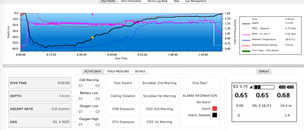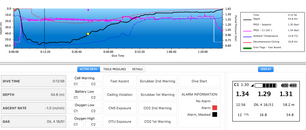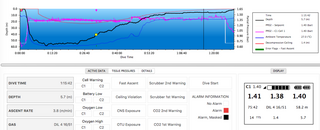fsardone
Solo Diver
What I think you are arguing (hard to know exactly because you are mixing depth with time) is the fCO2 is 0 at the start, 0.01% after 20mins, 0.02% after 40mins, 0.03% after 60mins etc etc. That is not how a scrubber works.
I believe I did not argue nothing of the sort.
ppC02 will stay zero until breakthrough. Which by the way is the literal meaning of the word
What I am saying is that breakthrough will happen sooner at depth.
The article you linked is at constant depth (I did not notice what depth, if it was specified at all) what I am discussing is a real dive: deep for the fun bit shallower for the boring deco ....
Maybe I was not clear.
At higher depth due to the fact that gas is denser the amount of CO2 coming from the metabolism is the same it is more diluted therefore you need to increase the depth of scrubber to cross for all of the CO2 molecules to come in contact with sorb and be adsorbed.
This means that since you use up sorb from the entry point of the gas, if the remaining portion of active scrubber is less than the lenght needed AT THAT DEPTH you have breakthrough. If you decrease depth you might still have enough unused (which can become active) scrubber to prevent breakthrough. This is why time and depth are linked.
If you have a temp stick and do a deep dive you will see how the active scrubber portion is function of depth.
The next 3 images are the screen shot of my reb logging software. This was a dive to about 58 meters 30 minutes bottom time and approx 90 total run time. Scrubber had been used, in a previous dive, 30 minutes at 54 meters I then bailed out to OC for deco (I was just training nothing dramatic) so this scrubber had 70 minutes left below 50 meters and 150 minutes usable scrubber time (according to manufacturer manual and tests).
You will notice (in the lower right of the pictures) the bar of the active portion of tthe scrubber. It runs from from left to right and you need to imagine gas entering from left.
First image: During the surface/shallow portion The scrubber is active from the beginning only 2 blocks.
Second image: At depth the initial portion of the scrubber is unable to react and cools down (two blocks off) buth the bar is longer (4 blocks) and starts from the third.
Third image: once I get back up in the shallow the initial portion of the scrubber heats up again, block 2 becomes hot again. What you do not see here is the last part of the scrubber cool down but it does. It will not receive CO2 to react with although it takes a long time to cool down because the gas is hot from reaction, but in a further shallow dive you would see that.
This is what I am arguing. And it is chemistry and physics that mixes up scrubber duration and depth, not me.
Hope this makes it clear. Recommend reading the book I mentioned in my previous post.
Cheers



Last edited:




